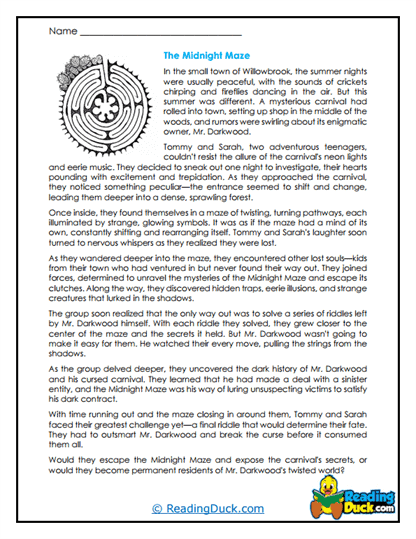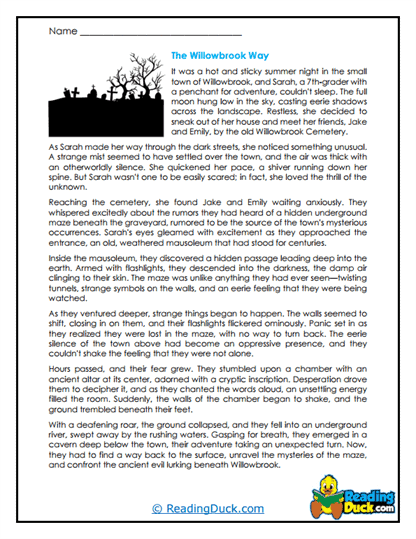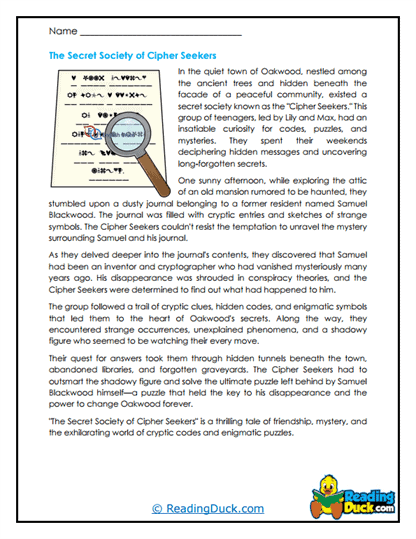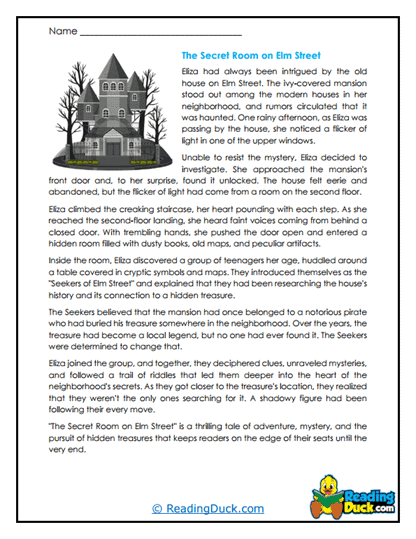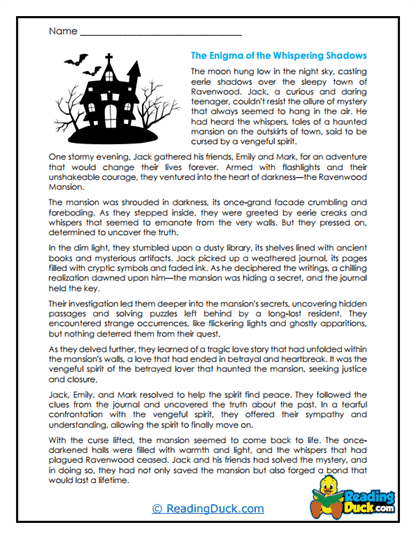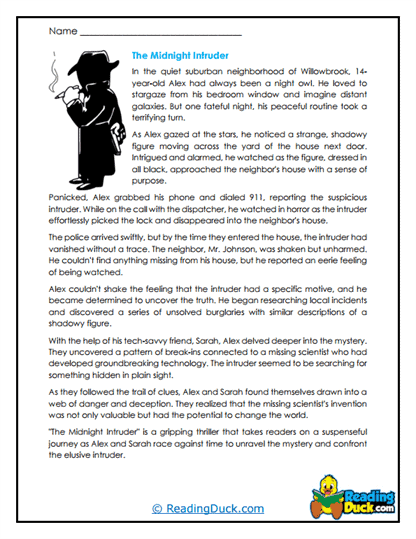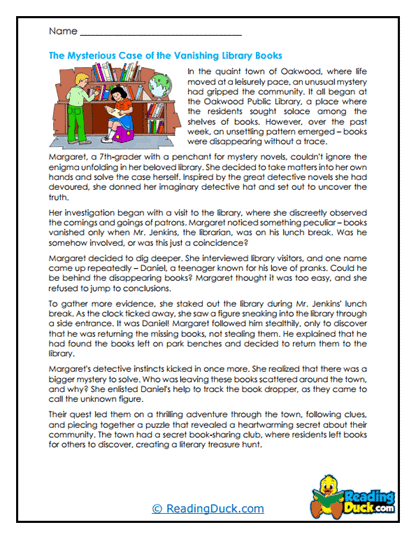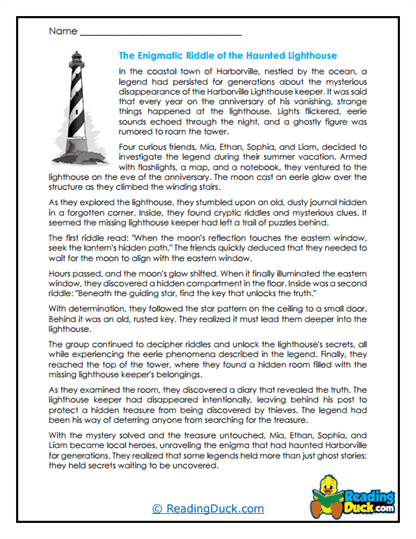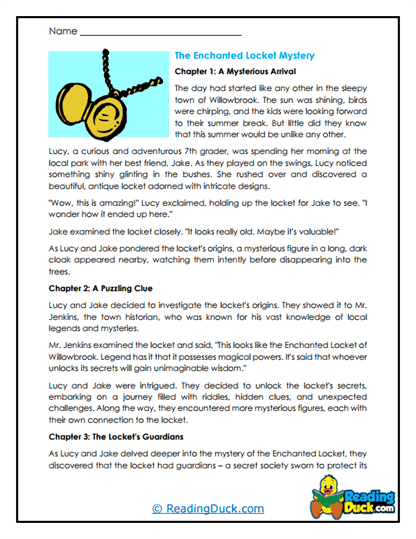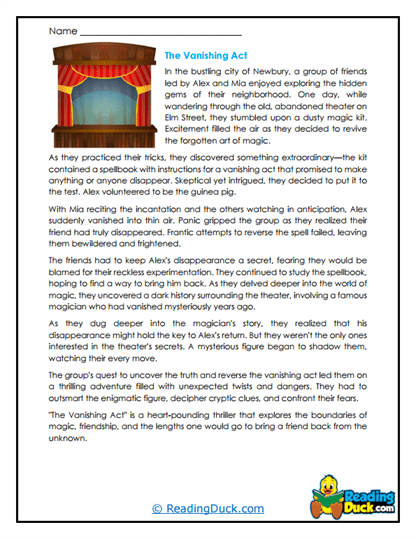Mystery and Thriller Worksheets
About Our Mystery and Thriller Worksheets
Our Mystery and Thriller Worksheets provide students with an immersive learning experience in one of the most captivating genres in fiction. Each worksheet set includes a carefully selected reading passage that exemplifies the key characteristics of mystery or thriller storytelling. Accompanying these passages are multiple-choice questions designed to test reading comprehension, short-answer questions that encourage deeper analysis, and open-ended prompts that foster creative thinking and writing. These worksheets are available in a PDF format, making them easy to download, print, and view on any device. Each set also includes a downloadable answer key to streamline grading and allow teachers to focus on engaging students in rich literary discussions.
These worksheets are particularly well-suited for middle school and high school students, but can also be adapted for upper elementary learners. The versatile format makes them an excellent resource for a variety of educational settings, including traditional classrooms, homeschooling environments, and independent study programs. Whether used as part of a larger unit on genre fiction or as standalone lessons, our Mystery and Thriller Worksheets are an engaging tool to promote critical thinking, creative expression, and a deeper understanding of storytelling techniques.
Exploring the Depths of Mystery and Thriller Fiction
Mystery and thriller fiction is defined by its ability to captivate readers through suspense, intrigue, and complex puzzles. In mystery fiction, the narrative typically revolves around solving a crime or uncovering hidden secrets, while thrillers often emphasize fast-paced action, high stakes, and the psychological tension of characters navigating dangerous situations. These two subgenres of fiction are rich in narrative complexity and are particularly effective at engaging readers by creating questions that demand answers.
The key themes and characteristics of mystery and thriller fiction include:
- Suspense and tension: Both genres thrive on keeping readers on edge, building anticipation through withheld information or unexpected twists.
- Complex puzzles: In mysteries, the central plot often involves solving a crime, with clues, red herrings, and misleading details that challenge readers to piece together the truth.
- High-stakes action: Thrillers, in particular, focus on intense situations where characters must navigate life-or-death scenarios.
- Character motivations: Whether detective, suspect, or hero, characters in these genres are often driven by deep psychological factors, and understanding their motivations is key to unraveling the plot.
These themes are essential to fiction because they not only entertain but also encourage readers to think critically, analyzing characters’ actions and decisions in order to solve the narrative’s central conflict. Our worksheets help students engage with these key elements, developing their ability to read closely, interpret complex plots, and anticipate story developments.
How Our Worksheets Build Critical Skills
Our Mystery and Thriller Worksheets are designed to develop a wide range of academic skills in students, going beyond simple reading comprehension. By working through passages that embody the intricacies of the genre, students sharpen their ability to think critically and creatively about what they read. Here are some of the ways these worksheets promote essential skills:
- Reading Comprehension: Multiple-choice questions ensure that students can grasp the key details of a text, from identifying suspects to understanding the sequence of events.
- Critical Thinking: Short-answer questions challenge students to analyze character motivations, decipher clues, and evaluate how authors build suspense or surprise through narrative techniques.
- Creative Expression: Open-ended questions inspire students to engage with the text on a deeper level, asking them to imagine alternate plot developments, create new mysteries, or develop suspenseful scenes of their own.
For example, after reading a passage about a detective investigating a series of mysterious break-ins, students may be asked to answer short-answer questions that analyze the detective’s strategy or to explain how a red herring misled the character. Open-ended prompts might encourage students to rewrite the ending, crafting their own surprise twist, or to imagine what clues they would add to create more suspense. These exercises help students develop both analytical and creative thinking skills, empowering them to engage more deeply with the genre.
Unlocking the Secrets of Mystery and Thriller Storytelling
Mystery and thriller fiction relies on unique storytelling techniques that keep readers engaged and guessing until the very end. Our worksheets focus on helping students explore these techniques, encouraging them to recognize how authors build tension, hide clues, and create complex, layered plots.
In mystery and thriller stories, students are encouraged to look beyond the surface and understand the narrative techniques that make the genre so thrilling. Some key storytelling techniques covered in these worksheets include:
- Building Suspense: Worksheets will often ask students to identify how the author builds suspense, whether through pacing, foreshadowing, or the strategic withholding of information.
- Creating Red Herrings: In mysteries, misleading clues are a crucial element, and students may be asked to explain how certain plot details misdirect the characters and the reader, adding complexity to the puzzle.
- Pacing in Thrillers: Fast-paced action and tension are hallmarks of the thriller genre, and students will analyze how the author uses short, punchy sentences or rapid shifts between scenes to keep the stakes high and the reader hooked.
For example, a worksheet might include a reading passage where a detective is closing in on a suspect, only to find out they’ve been following a false lead. In the multiple-choice section, students could be asked to identify the clues that pointed to the red herring, while the short-answer section might ask them to explain how the false lead heightened the tension. Open-ended questions could then challenge students to come up with their own misleading clues for a mystery of their design, allowing them to apply the genre’s techniques creatively.
Encouraging Analytical and Creative Skills Development
Our Mystery and Thriller Worksheets are crafted to enhance both creative thinking and analytical skills, essential for academic growth and personal expression. By engaging with stories that challenge them to think about how narratives are constructed, students will develop the tools necessary to analyze plot developments, interpret character motivations, and consider how authors craft tension and resolution.
These worksheets ask students to:
- Analyze the plot: Mystery and thriller stories often contain intricate plots, and students will be asked to identify the key turning points, explain how the plot escalates, and predict how it will resolve.
- Interpret character motivations: Students will consider why characters behave as they do, how their choices influence the story’s outcome, and what drives them to act in high-pressure situations.
- Explore alternate storylines: Open-ended questions often invite students to imagine different endings or consider how the story would change if a key event unfolded differently. This encourages both creative thinking and critical analysis, as students must understand the narrative fully before altering it.
For instance, a passage might involve a high-speed chase between a hero and a villain in a thriller. Students would analyze the motivations of both characters—why is the hero so determined to catch the villain, and what is driving the villain to flee? Then, an open-ended prompt might ask students to rewrite the scene from the villain’s perspective, offering them a creative opportunity to explore alternate viewpoints within the same high-stakes situation.
Versatility Across Educational Environments
These worksheets are highly versatile and can be incorporated into a range of educational environments. Whether you are teaching in a traditional classroom setting, homeschooling, or supporting independent study, our Mystery and Thriller Worksheets are a valuable tool for fostering student engagement with fiction.
- In traditional classrooms, these worksheets provide a structured way to explore the genre while allowing for flexible use in group discussions, individual assignments, or creative projects.
- For homeschooling, the PDF format makes these worksheets easy to download and print, providing a convenient resource for structured literary analysis.
- In independent study, students can work through the passages at their own pace, using the answer key to assess their comprehension and analysis.
Each worksheet set is designed to enhance students’ critical thinking and creative expression, making these worksheets perfect for language arts and literature classes that prioritize deeper engagement with texts. Teachers can easily integrate these worksheets into larger lessons on fiction, character development, or plot structure, using them to support classroom discussions or as part of assessments on narrative analysis.
Ideal for Independent and Collaborative Learning
Whether students are working individually or collaborating in groups, our Mystery and Thriller Worksheets offer a flexible format that supports both independent study and group discussions. In individual work, students can focus on developing their personal analytical skills and creative expression, while group discussions allow for the exchange of ideas, debates about characters’ motivations, and collaborative problem-solving as they work to unravel the mystery or understand the suspenseful elements of a story.
Ultimately, our Mystery and Thriller Worksheets are a comprehensive tool for helping students engage deeply with this exciting genre. By blending factual comprehension with creative engagement, these resources encourage active learning, promote critical thinking, and foster a love for creative writing, making them an indispensable resource for educators and students alike.
